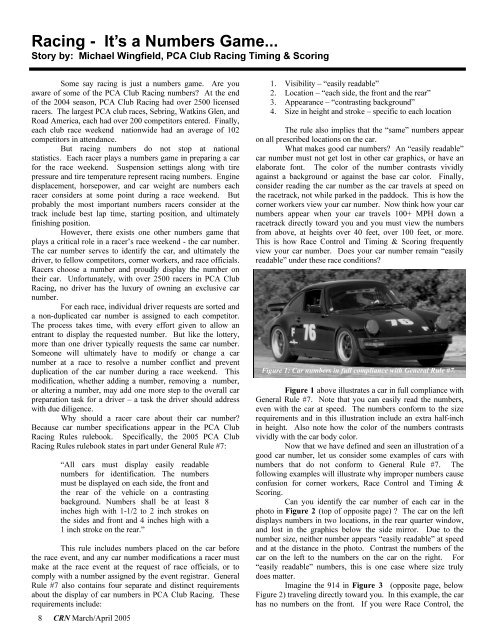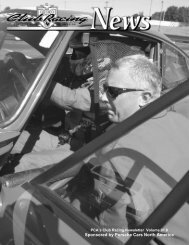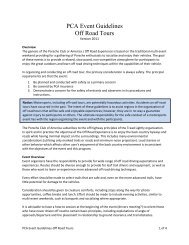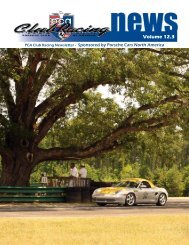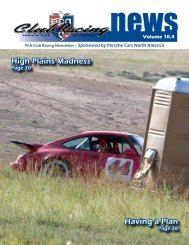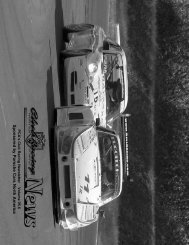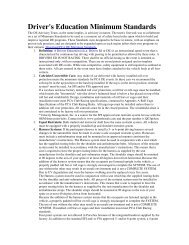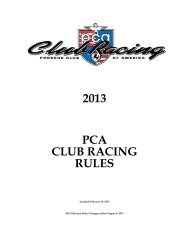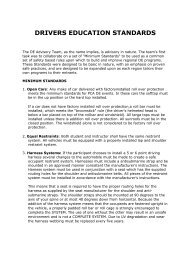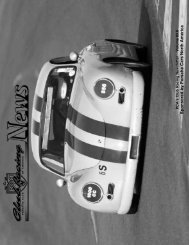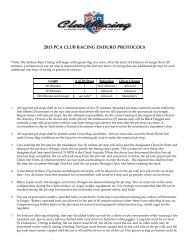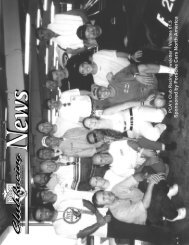Club Racing News052d.pub - Porsche Club of America
Club Racing News052d.pub - Porsche Club of America
Club Racing News052d.pub - Porsche Club of America
You also want an ePaper? Increase the reach of your titles
YUMPU automatically turns print PDFs into web optimized ePapers that Google loves.
<strong>Racing</strong> - It’s a Numbers Game...<br />
Story by: Michael Wingfield, PCA <strong>Club</strong> <strong>Racing</strong> Timing & Scoring<br />
Some say racing is just a numbers game. Are you<br />
aware <strong>of</strong> some <strong>of</strong> the PCA <strong>Club</strong> <strong>Racing</strong> numbers? At the end<br />
<strong>of</strong> the 2004 season, PCA <strong>Club</strong> <strong>Racing</strong> had over 2500 licensed<br />
racers. The largest PCA club races, Sebring, Watkins Glen, and<br />
Road <strong>America</strong>, each had over 200 competitors entered. Finally,<br />
each club race weekend nationwide had an average <strong>of</strong> 102<br />
competitors in attendance.<br />
But racing numbers do not stop at national<br />
statistics. Each racer plays a numbers game in preparing a car<br />
for the race weekend. Suspension settings along with tire<br />
pressure and tire temperature represent racing numbers. Engine<br />
displacement, horsepower, and car weight are numbers each<br />
racer considers at some point during a race weekend. But<br />
probably the most important numbers racers consider at the<br />
track include best lap time, starting position, and ultimately<br />
finishing position.<br />
However, there exists one other numbers game that<br />
plays a critical role in a racer’s race weekend - the car number.<br />
The car number serves to identify the car, and ultimately the<br />
driver, to fellow competitors, corner workers, and race <strong>of</strong>ficials.<br />
Racers choose a number and proudly display the number on<br />
their car. Unfortunately, with over 2500 racers in PCA <strong>Club</strong><br />
<strong>Racing</strong>, no driver has the luxury <strong>of</strong> owning an exclusive car<br />
number.<br />
For each race, individual driver requests are sorted and<br />
a non-duplicated car number is assigned to each competitor.<br />
The process takes time, with every effort given to allow an<br />
entrant to display the requested number. But like the lottery,<br />
more than one driver typically requests the same car number.<br />
Someone will ultimately have to modify or change a car<br />
number at a race to resolve a number conflict and prevent<br />
duplication <strong>of</strong> the car number during a race weekend. This<br />
modification, whether adding a number, removing a number,<br />
or altering a number, may add one more step to the overall car<br />
preparation task for a driver – a task the driver should address<br />
with due diligence.<br />
Why should a racer care about their car number?<br />
Because car number specifications appear in the PCA <strong>Club</strong><br />
<strong>Racing</strong> Rules rulebook. Specifically, the 2005 PCA <strong>Club</strong><br />
<strong>Racing</strong> Rules rulebook states in part under General Rule #7:<br />
“All cars must display easily readable<br />
numbers for identification. The numbers<br />
must be displayed on each side, the front and<br />
the rear <strong>of</strong> the vehicle on a contrasting<br />
background. Numbers shall be at least 8<br />
inches high with 1-1/2 to 2 inch strokes on<br />
the sides and front and 4 inches high with a<br />
1 inch stroke on the rear.”<br />
This rule includes numbers placed on the car before<br />
the race event, and any car number modifications a racer must<br />
make at the race event at the request <strong>of</strong> race <strong>of</strong>ficials, or to<br />
comply with a number assigned by the event registrar. General<br />
Rule #7 also contains four separate and distinct requirements<br />
about the display <strong>of</strong> car numbers in PCA <strong>Club</strong> <strong>Racing</strong>. These<br />
requirements include:<br />
8 CRN March/April 2005<br />
1. Visibility – “easily readable”<br />
2. Location – “each side, the front and the rear”<br />
3. Appearance – “contrasting background”<br />
4. Size in height and stroke – specific to each location<br />
The rule also implies that the “same” numbers appear<br />
on all prescribed locations on the car.<br />
What makes good car numbers? An “easily readable”<br />
car number must not get lost in other car graphics, or have an<br />
elaborate font. The color <strong>of</strong> the number contrasts vividly<br />
against a background or against the base car color. Finally,<br />
consider reading the car number as the car travels at speed on<br />
the racetrack, not while parked in the paddock. This is how the<br />
corner workers view your car number. Now think how your car<br />
numbers appear when your car travels 100+ MPH down a<br />
racetrack directly toward you and you must view the numbers<br />
from above, at heights over 40 feet, over 100 feet, or more.<br />
This is how Race Control and Timing & Scoring frequently<br />
view your car number. Does your car number remain “easily<br />
readable” under these race conditions?<br />
Figure 1: Car numbers in full compliance with General Rule #7.<br />
Figure 1 above illustrates a car in full compliance with<br />
General Rule #7. Note that you can easily read the numbers,<br />
even with the car at speed. The numbers conform to the size<br />
requirements and in this illustration include an extra half-inch<br />
in height. Also note how the color <strong>of</strong> the numbers contrasts<br />
vividly with the car body color.<br />
Now that we have defined and seen an illustration <strong>of</strong> a<br />
good car number, let us consider some examples <strong>of</strong> cars with<br />
numbers that do not conform to General Rule #7. The<br />
following examples will illustrate why improper numbers cause<br />
confusion for corner workers, Race Control and Timing &<br />
Scoring.<br />
Can you identify the car number <strong>of</strong> each car in the<br />
photo in Figure 2 (top <strong>of</strong> opposite page) ? The car on the left<br />
displays numbers in two locations, in the rear quarter window,<br />
and lost in the graphics below the side mirror. Due to the<br />
number size, neither number appears “easily readable” at speed<br />
and at the distance in the photo. Contrast the numbers <strong>of</strong> the<br />
car on the left to the numbers on the car on the right. For<br />
“easily readable” numbers, this is one case where size truly<br />
does matter.<br />
Imagine the 914 in Figure 3 (opposite page, below<br />
Figure 2) traveling directly toward you. In this example, the car<br />
has no numbers on the front. If you were Race Control, the


